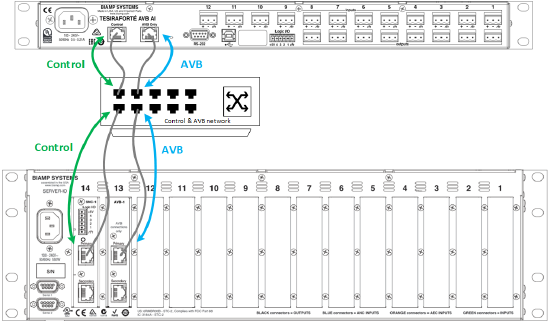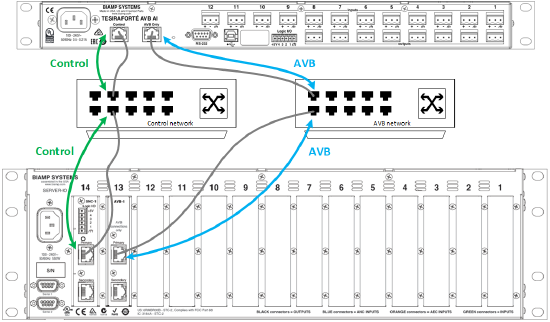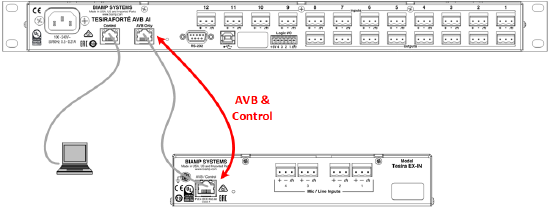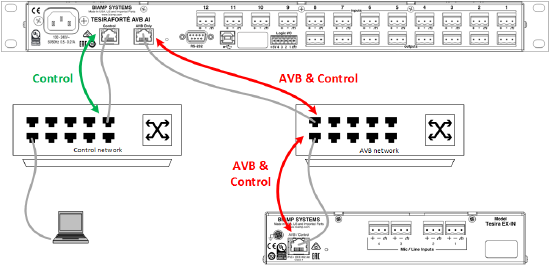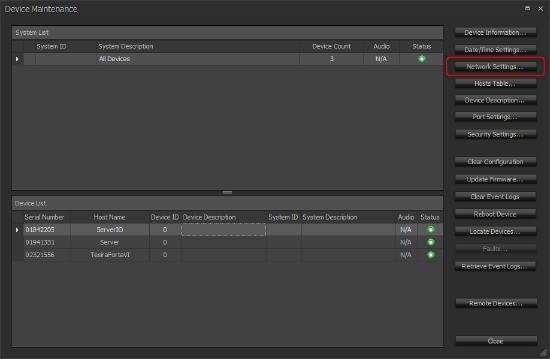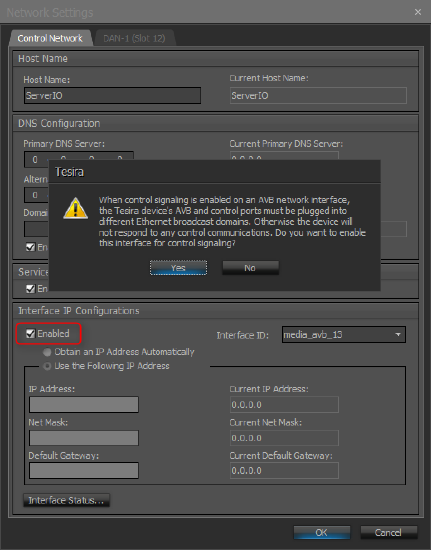Separated or converged Control and AVB networks
This document explains how to configure a Tesira system to function correctly on the two types of network topology that Tesira supports: separate control and AVB media networks, or a single converged network for both control and AVB.
It also explains how to directly attach a TCM-1, TCM-1A, AMP-450P, or an audio Expander to the AVB port of a TesiraFORTÉ, SERVER or SERVER-IO.
Note: this document applies to Tesira firmware versions 2.4 - 3.7.1.5.
When using Tesira firmware version 3.8 and beyond, more options are available as detailed in this article.
Overview
Devices with dedicated ports for control and AVB
Any Tesira Server-class device which has dedicated network ports for control and for AVB can function in either type of network topology without any additional configuration. These devices include the SERVER, SERVER-IO, Tesira AMP, TesiraLUX, and all AVB-capable devices in TesiraFORTÉ range.
Devices with a single port for control and AVB
Many Tesira devices have a single network port for both control and AVB. The single-port devices include the AMP-450P, the TCM-1 and TCM-1A, and all audio Expanders. Audio Expanders use IP addresses for control data. The AMP-450P, the TCM-1 and TCM-1A do not use IP addressing at all - they are Layer 2 devices.
Converged and separated network topologies
A Tesira system can be configured to work with the network topology designed in one of two ways, converged or separated.
Converged
The TesiraFORTÉ and the SERVER-IO will exchange control information via their control network ports and exchange audio data via their AVB network ports. Although all four network ports are connected to the same network, there is no exchange of data between the control ports and the AVB ports.
AVB routing and discovery is done via Layer 2 MAC address and the AVB ports do not acquire an IP address. In the Network Settings tab of the Tesira software you will note the AVB interface shows an IP assignment of 0.0.0.0
In this example, a single network (or VLAN) is used for control and AVB media data:
Figure 1 - converged control and AVB media networks
In a Tesira system running on a converged network topology, the single-port devices exchange audio and control data with the dual-port devices through an AVB-capable network switch, like this:
Figure 2 - expander device in a converged network topology
Separated
The TesiraFORTÉ and the SERVER-IO will exchange control information via their control network ports and exchange audio data via their AVB ports. The control ports and the AVB ports do not need to exchange any data, so it does not matter that they are connected to different networks. Each network must have a unique subnet.
In this example, control and AVB media networks are physically separate (or logically separated using VLANs):
Figure 3 - separated control and AVB media networks
For single-port devices to operate in a separated network topology, we must enable control functionality on the AVB ports of any SERVER, SERVER-IO, or TesiraFORTÉ devices in the system to allow them perform device discovery and control operations via their AVB network interfaces.
The simplest application of this feature is a 2 device system with an AMP-450P, TCM-1, TCM-1A, or an Expander connected directly* to the AVB network interface of a TesiraFORTÉ, SERVER or SERVER-IO.
Figure 4 - Expander direct connection (a type of separated network topology)
(*Remote expanders are PoE+ powered, so an inline PoE+ power source is required.)
Note that the AVB port must have an IP address in a different subnet than the control port. If there is no DHCP server connected to the AVB port then it will acquire a link local (169.254.xxx.yyy) address. If the control port is also on a network with no DHCP server present it will also acquire a link local (169.254.xxx.yyy) address. When Tesira sees this behavior it will disable the AVB port and remote devices will be undiscoverable. The simplest solutions are to either set the control interface to a static IP address (outside of the link local range) or enable a DHCP server on the control network. Once the control and AVB ports are in unique subnets the AVB port will behave normally again and remote devices will be discoverable.
In larger installations, the Tesira system can share the building’s network for control purposes, and a separate, dedicated AVB media network can be installed alongside it. The decision on whether or not to connect the two networks can be made according to user requirements.
Separated mode allows single-port devices to exchange audio and control data with the dual-port devices like this:
Figure 5 - Expander device in a separated network topology
Summary
For Tesira versions 2.4 and later, the network infrastructure can be configured in one of two ways, regardless of the number and type of devices in the system:
- The default setting: to use a converged control and AVB media network
The system will use a single network, common for both the AVB audio and control functions of the system
- The optional setting: to use separated control and AVB media networks
The system will use two unconnected networks:
i) The control network, for all control functions apart from the management of audio expanders
ii) The AVB media network, for AVB audio and video transport and the management of expanders†.
Notes:
The requirements for using separated networks are a little more complex. For example, the control and AVB media networks must be physically or logically separated, and the IP addresses for each network must be in different subnets. See Essential rules for more information.
†Logic expanders (e.g., EX-LOGIC) and remote control devices (e.g., TEC-1, TEC-1 and HD-1) may be placed on either network.
Implementing separated networks for systems with single-port Expander devices
Enable IP on the AVB interface
Implementing separated networks is simple to do from the Device Maintenance dialog.
When changing IP schemes remember to always work from devices on the edges of the system to the center. Changes to Expander IP addresses should be made first, while they are visible on the same network as the Server-class hardware. Then apply changes to the Server-class hardware to join the new network that the Expanders were moved to.
From the System menu, select Network then Perform Device Maintenance. In the Device Maintenance dialog, select a device in the Device List, then on the right-hand side of the dialog press the Network Settings button.
Figure 4 - Device Maintenance dialog
The Network Settings dialog will display the settings for the Control NIC by default.
In the drop down list in the Interface IP Configurations section, select the AVB media NIC.
(In a SERVER: avb_media_02 or avb_media_01; in a SERVER-IO: avb_media_13; in a TesiraFORTÉ: avb_media_0).
Figure 5 - select the AVB interface in Network Settings
Check the Enable box to activate the IP configuration for the AVB interface. This will enable the device's AVB network interface to discover Tesira's expander and control devices.
Note the warning message, and ensure that the device's control and AVB media network interfaces are not connected to the same Ethernet broadcast domain. See the Essential rules section for more information.
Figure 6 - enable IP communication on the AVB network interface
IP Address setting
The default setting for the interface is to receive an IP address automatically (DHCP or Link Local). To manually configure with a static IP address, select Use the Following IP Address.
Ensure that the IP addresses used for two interfaces are on different subnets from each other, and pay particular attention when both interfaces are set to receive an IP address automatically.
See the Essential rules section for more information.
Essential rules
There are some simple but important rules to remember, all of which derive from standard networking practices. Failure to follow these rules may result in failure to discover and/or firmware update Tesira expanders and controllers, inconsistent devices when sending configurations, DSP unable to see each other, and preset recall failures.
If a Tesira SERVER, SERVER-IO, TesiraLUX, TesiraFORTÉ X, or Legacy TesiraFORTÉ is configured to use separated control and AVB media networks:
- The control and AVB media networks must be physically separated or logically separated (using VLANs).
If the two networks are connected to the same Ethernet broadcast domain, Tesira devices may become unresponsive.
- The IP addresses of each network must be in different (non-overlapping) subnets.
If the IP addresses of the control network and AVB media network are in the same subnet, Tesira devices may become unresponsive and Tesira expanders may fail firmware updates.
- If the Tesira devices have both their control and AVB media networks configured to “Obtain an IP Address Automatically”, then a DHCP server must be present on at least one of the networks.
- If neither network has a DHCP server, then both the interfaces will try to use IP addresses in the Link Local range of 169.254.xxx.xxx. This would violate rule 2.
- Should this situation occur, the Tesira device will temporarily inhibit the AVB network interface and expander firmware updates will fail.
- If neither network has a DHCP server, then both the interfaces will try to use IP addresses in the Link Local range of 169.254.xxx.xxx. This would violate rule 2.


